
Concept explainers
Draw the products formed in each reaction.
a.  e.
e. 
b.  f.
f. 
c.  g.
g. 
d.  h.
h. 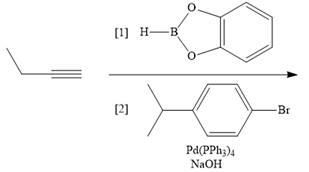
(a)
Interpretation: The product formed in the given reaction is to be drawn.
Concept introduction: The treatment of
Answer to Problem 26.34P
The product of the given reaction is,
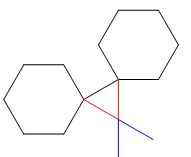
Explanation of Solution
The given reaction involves treatment of an alkene with
The treatment of
The corresponding reaction is shown below.

Figure 1
Thus, the product of the given reaction is,

Figure 2
The product of the given reaction is drawn in Figure 2.
(b)
Interpretation: The product formed in the given reaction is to be drawn.
Concept introduction: The treatment of an organic halide with an alkene in the presence of
Answer to Problem 26.34P
The product of the given reaction is,

Explanation of Solution
The given reaction involves treatment of an organic halide with an alkene in the presence of
The treatment of an organic halide with an alkene in the presence of
The corresponding reaction is shown below.

Figure 3
Thus, the product of the given reaction is,

Figure 4
The product of the given reaction is drawn in Figure 4.
(c)
Interpretation: The product formed in the given reaction is to be drawn.
Concept introduction: The treatment of an organic halide
Answer to Problem 26.34P
The product of the given reaction is,
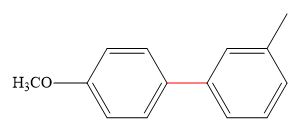
Explanation of Solution
The given reaction involves treatment of an organic halide with an organoborane reagent in the presence of
The treatment of an organic halide
The corresponding reaction is shown below.

Figure 5
Thus, the product of the given reaction is,

Figure 6
The product of the given reaction is drawn in Figure 6.
(d)
Interpretation: The product formed in the given reaction is to be drawn.
Concept introduction: The treatment of an organic halide
Answer to Problem 26.34P
The product of the given reaction is,

Explanation of Solution
The given reaction involves treatment of an organic halide with an organoborane reagent in the presence of
The treatment of an organic halide
The corresponding reaction is shown below.

Figure 7
Thus, the product of the given reaction is,

Figure 8
The product of the given reaction is drawn in Figure 8.
(e)
Interpretation: The product formed in the given reaction is to be drawn.
Concept introduction: The ring-closing metathesis (RCM) by Grubbs catalyst occurs, when the starting material is diene. This reaction is facilitated under high-dilution condition as it favors intramolecular metathesis instead of intermolecular metathesis.
Answer to Problem 26.34P
The product of the given reaction is,
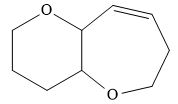
Explanation of Solution
The given reaction involves treatment of a diene with Grubbs catalyst.
The ring-closing metathesis (RCM) by Grubbs catalyst occurs, when the starting material is diene. This reaction is facilitated under high-dilution condition as it favors intramolecular metathesis instead of intermolecular metathesis.
The corresponding reaction is shown below.
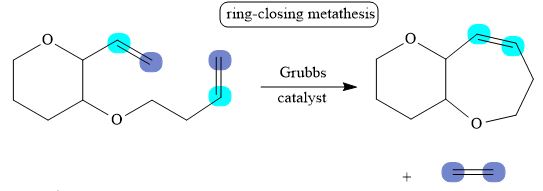
Figure 9
Thus, the product of the given reaction is,

Figure 10
The product of the given reaction is drawn in Figure 10.
(f)
Interpretation: The product formed in the given reaction is to be drawn.
Concept introduction: The nonhalogenated cyclopropanes are synthesized by the treatment of an alkene with
Answer to Problem 26.34P
The product of the given reaction is,
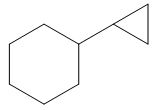
Explanation of Solution
The given reaction involves treatment of an alkene with
The nonhalogenated cyclopropanes are synthesized by the treatment of an alkene with
The corresponding reaction is shown below.

Figure 11
Thus, the product of the given reaction is,

Figure 12
The product of the given reaction is drawn in Figure 12.
(g)
Interpretation: The product formed in the given reaction is to be drawn.
Concept introduction: The treatment of an organic halide with
Answer to Problem 26.34P
The product of the given reaction is,
![]()
Explanation of Solution
The given reaction involves treatment of chlorobutane with
The treatment of an organic halide with
The corresponding reaction is shown below.

Figure 13
Thus, the product of the given reaction is,
![]()
Figure 14
The product of the given reaction is drawn in Figure 14.
(h)
Interpretation: The product formed in the given reaction is to be drawn.
Concept introduction: The treatment of an organic halide
Answer to Problem 26.34P
The product of the given reaction is,
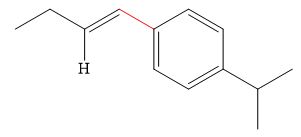
Explanation of Solution
The given reaction involves treatment of an alkyne with an vinylborane, followed by treatment with organic halide in the presence of
The treatment of given alkyne with catecholborane leads to the formation of corresponding vinylborane in first step. This vinylborane (an organoborane) is formed by hydroboration which adds
The treatment of an organic halide
The corresponding reaction is shown below.
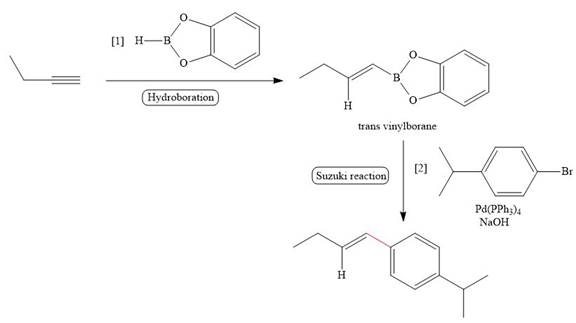
Figure 15
Thus, the product of the given reaction is,

Figure 16
The product of the given reaction is drawn in Figure 16.
Want to see more full solutions like this?
Chapter 26 Solutions
PKG ORGANIC CHEMISTRY
Additional Science Textbook Solutions
Fundamentals of Anatomy & Physiology (11th Edition)
MARINE BIOLOGY
HUMAN ANATOMY
Loose Leaf For Integrated Principles Of Zoology
Organic Chemistry
Human Anatomy & Physiology (2nd Edition)
- Draw a tetramer of this alternating copolymer.arrow_forwardH I T H HH H -H C. H- Identify and select all structures below that represent a constitutional isomer(s) of the compound shown above. H- H CIH H H H HHHH H H 0 ·H H– 冊 CH CHI HH C- H- H H- H H A. H H C H H- -H HH H B. H- -H D. H H H H • H -H E. -H H H HICH T HHH F. H-arrow_forwardPolylactic acid (shown below) is a biodegradable polymer used for food packaging. Identify the monomer(s) used in the production of this polymer using a condensation process.arrow_forward
- Draw the product of the reaction shown below. Ignore small byproducts that would evaporate pleasearrow_forwardPoly(ethylene adipate) is a biodegradable polyester (shown below). Identify the type of polymerization process used in the production of this polymer.arrow_forwardPolymers may be composed of thousands of monomers. draw two repeat units(dimer) of the polymer formed in this reaction. assume there are hydrogen atoms on the two ends of the dimer. ignore inorganic byproducts pleasearrow_forward
- Draw the product of the reaction shown below. Use a dash or wedge bond to indicate stereochemistry of substituents on asymmetric centers, Ignore inorganic byproductsarrow_forwardDraw the product of this reaction please. Ignore inorganic byproductsarrow_forwardOne of the pi molecular orbitals of 1,3-butadiene (CH2=CHCH=CH2) is shown below. Please identify the number of nodal planes perpendicular to the bonding axisarrow_forward
- Draw the monomers required to synthesize this condensation polymer please.arrow_forwardProvide the correct systematic name for the compound shown here. Please take into account the keyboard options belowarrow_forwardcurved arrows are used to illustrate the flow of electrons. using the provided starting and product structures, draw the curved electron-pushing arrows for the following reaction or mechanistic step(s)arrow_forward
 Organic ChemistryChemistryISBN:9781305580350Author:William H. Brown, Brent L. Iverson, Eric Anslyn, Christopher S. FootePublisher:Cengage Learning
Organic ChemistryChemistryISBN:9781305580350Author:William H. Brown, Brent L. Iverson, Eric Anslyn, Christopher S. FootePublisher:Cengage Learning
